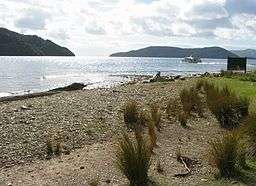Ship Cove (New Zealand)
Meretoto / Ship Cove is a small bay in the Marlborough Region of New Zealand, renowned as the first place of prolonged contact between Māori and Europeans.[1] It is located near the entrance of Queen Charlotte Sound / Tōtaranui, west of nearby Motuara Island and Long Island.
| Meretoto / Ship Cove | |
|---|---|
 View across the sound to Motuara Island from Ship Cove in 2004 | |
| Location | Marlborough Sounds |
| Coordinates | 41°05′35″S 174°14′20″E |
Explorer James Cook anchored his ships here and hence named it Ship Cove; however, in 2014 the official name was altered to "Meretoto / Ship Cove", to reflect its original Māori name.[2] While Ship Cove is a descriptive name, little is known about the origin of the name Meretoto. One possible translation is "bloody mere".[3][4]
Approximately 1,700 acres (6.9 km2) of land at the cove was declared a scenic reserve in administered by the Ship Cove Scenic Reserves Board.[5] In 1987, responsibility for the Ship Cove Historic Reserve passed to the Department of Conservation (New Zealand).[6] The site is a Category 1 listed historic place.[7]
The first explorers
It is believed that the first person to visit Tōtaranui was the great Polynesian explorer, Kupe, and the area abounds in Kupe place names.[6] The entrance to the sound was a jumping off point between Te Ika-a-Māui / the North Island and Te Waipounamu / the South Island, and the cove was valued by Māori as a place of shelter before crossing the strait and as a place to rest up after the trip.[8]
In the late 1770s, people did not live permanently at the cove. They came to fish and gather seasonal foods in the summer.[6]
James Cook's visits
On 15 January 1770, Cook anchored HMS Endeavour in the cove, and used it as a base to replenish supplies of food, water and wood after his long Pacific voyage.[9] While his ship was overhauled at anchor, Cook made a headquarters on the shore, ordering the planting of vegetable gardens and construction of an enclosure for pigs.[5] Cook would return to the cove a further five times over the course of his first, second and third voyages to the Pacific Ocean,[5][6] In other parts of New Zealand the contact was brief, but here it was sustained.[10]
After Cook’s visit
The publication of Cook’s First Voyage put Ship Cove on the world map, drawing whalers and other explorers to it. By 1810, whalers had called in there. People from Anaho were in close contact with whalers. They became Christians and some learned to read and write.[6]
In May 1820, the Russian ships Vostók and Mirnyy under the command of Fabien von Bellingshausen sailed into the bay, using a chart based on one made on Cook’s first voyage, and anchored in the shelter of Motuara Island, where HMS Resolution had anchored in May 1773. He and his men had cautious but friendly contact with the local Māori, trading knifes and axes for fish and curios, many of which are now held by museums in St Petersburg and Kazan].[6] Colonel William Wakefield, one of the founders of Wellington, also anchored his ship Tory in the cove in 1839.[5]
Māori chiefs from the area signed the Treaty of Waitangi on the 4th and 5th of May, and 17th June 1840.
References
- "Dual heritage / shared future". Tuia 250 Totaranui Marlborough Trust. Retrieved 30 May 2020.
- "NZGB decisions". Land Information New Zealand. August 2014. Archived from the original on 21 November 2015. Retrieved 7 November 2015.
- "Tuia - Encounters 250: Cook's place names around New Zealand - Meretoto / Ship Cove". Land Information New Zealand (LINZ). Retrieved 30 May 2020.
- "NZGB Gazetteer | linz.govt.nz". gazetteer.linz.govt.nz. Retrieved 2020-05-30.
- A.H. McLintock, ed. (1966). "Ship Cove". An Encyclopedia of New Zealand. Ministry for Culture and Heritage/Te Manatū Taonga, Government of New Zealand. Retrieved 5 October 2018.
- Celebrating Ship Cove (Interpretation panels adjacent to the Cook Monument). Ship Cove Reserve: Department of Conservation. 2006.
- "Search the List | Meretoto/Ship Cove | Heritage New Zealand". www.heritage.org.nz. Retrieved 30 May 2020.
- "Meretoto/Ship Cove". Department of Conservation New Zealand. Retrieved 30 May 2020.
- Rigby, Nigel; van der Merwe, Pieter (2002). Captain Cook in the Pacific. National Maritime Museum (UK). p. 35. ISBN 0-948065-43-5.
- ""The Flyer" Magazine Spring/Summer issue 2018/19". Issuu. Retrieved 30 May 2020.